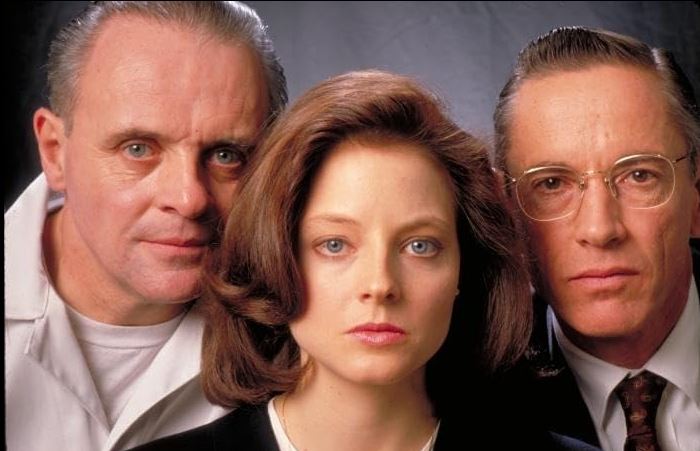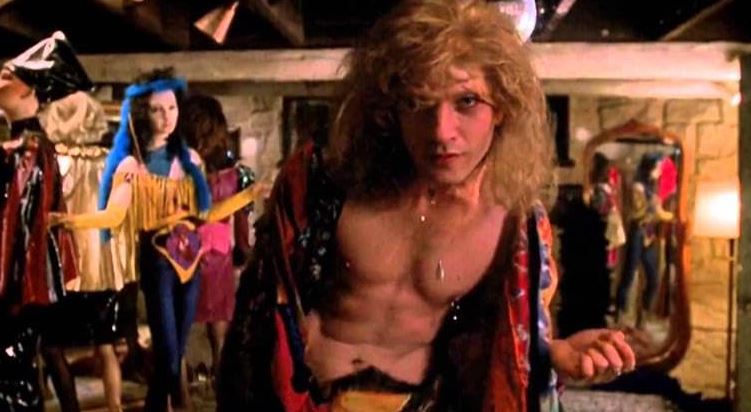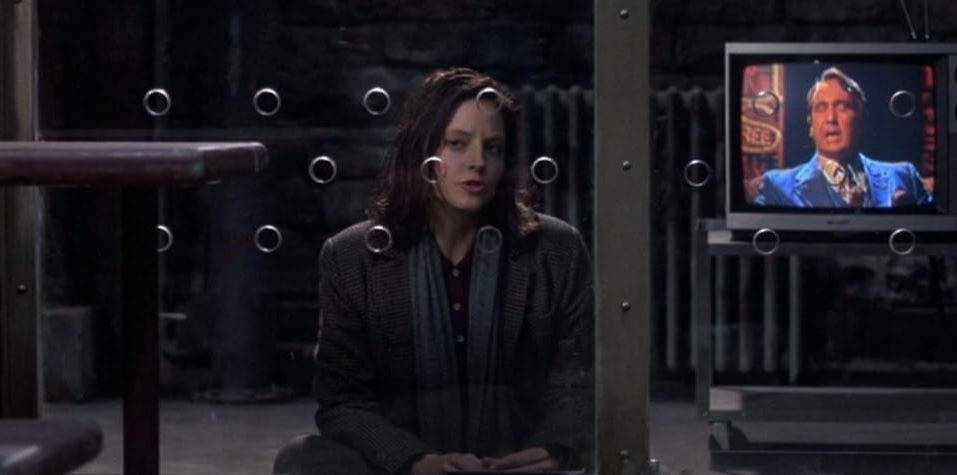
Despite what the sequels devolved into, The Silence of the Lambs is a not a film about serial killers and sociopaths, nor pathology and forensic psychiatry, nor statewide manhunts and federal investigations. The film that sired all this had this but served more because the revelation at its conclusion is none of the above but something akin to a coming of age, a rite of passage and a baptism of fire all at once.
Seeing it in bits two decades ago, and in totality somewhat recently, these fragmented viewings had initially built the skewed image of a brilliant criminal mastermind’s elaborate crime spree hatched in incarceration. Such is the peril of romanticizing villainy, which sequels kept falling back on. At first, the film’s title misled me multiple times. In one instance, I erroneously pondered the fate of several possible victims kept in captivity.
In an alternate universe, a nefarious scenario involving the choice of whom to spare might have turned Starling’s redemption nihilistic if not more compelling. From its title, I’d also imagined that the few who had gotten away shall not remain silenced by the ineptitude of investigators’ making meager headway liberating or avenging them. That it was a form of unheeded feminism, instead of the competent feminine Crawford (Glenn) sought to engender in Starling (Foster), which she, in turn, strove for and employed in her forensic inquiry. It was something else altogether; a centerpiece encounter, with souls bared among unlikely confidants.

But, more than the usual characteristics associated with serial killer portrayals with a sexual bent, more than the scars left in the wake of these highly motivated practitioners of uninvited intimacy, Demme’s idea of horror entailed pivoting to a series of tense encounters between a seasoned conversationalist and a reticent interrogator. The former (Hopkins) is psychiatrist-turned-serial killer; his opposite number (Foster) is the FBI cadet tasked with picking his brains to foil a suspect in an ongoing interstate rampage. Why Lecter agrees to help the fledgling talent is not due to a newfound altruism, a misanthropy softened by old age, nor the promise of easier confinement.
It is possible the thrill of seeing former glories revived enticed him to no end. And seizing the opportunity to practice his old craft on the green recruit, while a motivator on its own, is not the sole motive. His taking a liking to Starling’s tough chin in the face of initial hazing is all the background needed for a compelling dynamic to flourish from. Because, cannibalistic compulsions aside, he is a fine personality archetype; a verbose specimen whose precise barbs offer a regulating force where inhibitions fail in social settings.
It is no wonder, then, that Lecter’s pathology (retconned for longevity and butchered in haste by the looks of it) was left for later novels to explore and flesh out, and I’ll wager that, as always, the more intriguing mysteries are those left obscured. As he veered closer to a blunt and conspicuous depiction, Demme proved no different for recognizing the operatic potential of Lecter’s barbaric flair. When his keen olfactory sense was revealed, it figured less into his aura that he correctly guessed Starling’s perfume than the probing observation itself. That it seemed to be correct was, perhaps, too on the nose, when the intrusion and eccentricity behind the query sufficed on their own. The suggestion that psychological tells, ticks or personality quirks, can be gleaned from trivial accessorizing is sufficient to cause the recipient of such declarations to sit up in attention.

And one need only look at the effort put into naming subsequent novels to glean where the thrust of creativity was likely concentrated. Because must villainy be theatrical? And be imbued with an amplified refinement so as to make it misunderstood, or tragic, even? If so, perhaps, the blandly named sequels will have benefited from a strong title because, time and again, ask the uninitiated which of the four titles does not fit in, and Silence is likely to be the thematic outlier.
Despite a propensity for obscenities, we see no sexual kick behind Lecter’s affinity for Starling, only an intellectual gratification. It is a suspicion debunked in how he and another inmate comment respectively on her fragrance and scent; a refrain played in the sexist treatment from male peers. In exchange for his help, Starling is to engage Lecter in his game of tell-all, or in Lecter’s mind, psychiatry’s ’21 questions.’
For her part, Starling obliges out of a sense of duty but soon finds herself divulging repressed memories leading to her awakening. Here, the title reveals that the abstractions of memory and trauma resonate deeper than those of evocative imagery in the Red Dragon or, worse, eponymy (Hannibal / Rising). Outside of their conversations, the film assumes the form of a procedural, or the appearance of one rather than one in essence.
This investigative drudgery proves a tedium of its own as opposed to passages intended to break a different kind of tedium elsewhere. A lesser director might have approached the material this way, and hedged their bets with beefed-up side plots (Lecter’s disappearing act certainly fits) in case the showpiece duels proved a misfire. Ultimately, this police work reveals Starling’s tenacity more than any intriguing aspect of its own, and those passages pale in comparison to the brief glimpses of the duo of loons.
To Demme’s credit, the tension of a three-character dynamic is maintained consistently, allowing for anticipation to grow. Despite the monster in captivity and the one in the wild sharing a proclivity to flaying bodies, disparate temperaments and intellect set them decidedly apart. For one, seeing Buffalo Bill fairly early abducting one victim (the one integral to the plot) allows sufficient urgency to develop. Seeing his later clumsiness, however, cheapens a menacing aura carefully cultivated off-screen. Freedom is a waste when it brings no fortune to the free and one wonders what else Lecter would yearn for if left unshackled and given free rein.

Up to now, Starling’s investigation has centered around previous murders, piecing clues from prior crime scenes to uncover future whereabouts. Having been eased into Bill’s modus operandi, witnessing that same abductee (a senator’s daughter, if kidnapping wasn’t grave already) be forced into participating in her own ritualized demise is perhaps the most disturbing realization. Slowly, this manhunt resembles a trapper’s pursuit of a feral animal, compared to the velvet gloves used for handling Lecter’s urbane, cosmopolitan beast. In the final confrontation between Bill and Starling, we witness a sequence staging the climax like big game hunting.
In Bill’s underground den, all structural and visual norms are thrown off-kilter; there are exposed beams and raw dirt and the unlit maze seems to stretch beyond the boundaries of the floors above. This is the lower pit of Bill’s dark soul and the fuzzy night vision scope befits the superficial scrutiny afforded to the minuscule forensic value of the culprit’s unsophisticated brain. Or perhaps it is the rendering of the abyss inside Clarice where the lambs can still be heard screaming.
Despite minor blemishes, it is safe to proclaim The Silence of The Lambs’ brilliance as undiminished. Sure, it set a trend that glamorizes a brand of histrionic mayhem draped in sophisticated regalia but it more than earned a pass for a restrained debut for Lecter, in retrospect. There’s an irony in that breakthroughs take Starling back to her own backyard; the hillbilly coal belt—appropriate knowing the journey is as much inward as it is across jurisdictions.
Meanwhile, Crawford pedals furiously outside Chicago after the wrong lead, and waxes philosophical about benevolent misogyny and face-saving behind the thin blue line. And although for Clarice, gender politics, glass ceilings or corporate ladders may be her boogeymen, her odyssey, above all, was how when facing the void turns your reflection back instead of what you feared.
Leave a Reply